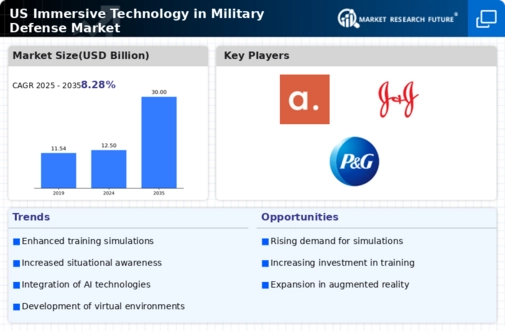The US Immersive Technology in Military Defense Market is rapidly emerging as a pivotal sector, reflecting the increasing integration of advanced technologies into military operations and training. This market encompasses a broad array of solutions, including augmented reality, virtual reality, and simulation technologies, which are utilized to enhance the capabilities of military personnel, improve training methodologies, and streamline operational efficiency. Competitive insights within this domain indicate a blend of established defense contractors and innovative startups, all vying for leadership positions through the development and deployment of cutting-edge immersive technologies designed to address the unique challenges faced by the military.
As nations focus on modernizing their armed forces and adapting to new warfare paradigms, companies in this space are expanding their offerings, enhancing partnerships, and prioritizing research and development to capitalize on emerging opportunities.Raytheon Technologies holds a prominent position in the US Immersive Technology in Military Defense Market, leveraging its extensive experience and capabilities in defense and aerospace to develop innovative solutions. The company’s strong presence is reinforced by its ongoing investments in research and development, which facilitate the creation of advanced training systems that incorporate immersive technologies.
Raytheon Technologies is recognized for its ability to provide robust simulation solutions that enable realistic training environments for military personnel, enhancing preparedness and operational effectiveness. By focusing on innovation and leveraging its strong technical expertise, the company has significantly contributed to the advancement of training simulations, ensuring that military forces can adapt to rapidly changing operational scenarios while enhancing teamwork and situational awareness.
Boeing is also a key player in the US Immersive Technology in Military Defense Market, with a strong portfolio of products and services designed to support military training and operational readiness. The company’s offerings include flight and simulation training systems, immersive training solutions for ground forces, and advanced visualization tools aimed at improving decision-making in complex environments. Boeing's strengths lie in its robust engineering capabilities and commitment to integrating the latest technological advancements into its training programs.
The company has actively engaged in strategic mergers and acquisitions to bolster its presence in the immersive technology space, thereby enhancing its service offerings and expanding its market reach. This proactive approach enables Boeing to remain competitive while delivering tailored solutions that meet the specific needs of the US military and allied forces, reinforcing its role as a critical partner in national defense.













